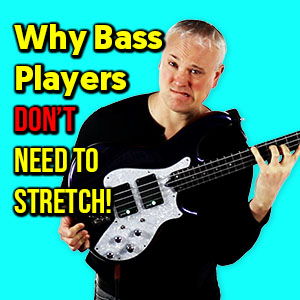Some great exercises and tips on alternate fingerpicking for bass guitar. The lesson covers odd accent groupings, odd time signatures and advanced string crossing.
What Is Alternate Picking?
When we play fingerstyle on the bass, it makes sense to use our fingers in the most efficient and logical way. Most people use two fingers and alternate them (you can use more or less picking fingers but it is up to personal preference). Alternate picking involves playing consistently between the 1st and 2nd fingers on the right hand. You can start on either finger which means that it is easy to lose track of what finger comes next. If you don’t pay attention to what fingers you are using then you could end up raking across strings or using one more than the other.
The first exercise we can practice to improve our alternate picking simply goes up and down the C major scale. It may seem easy at first, but if you slow it right down you might find it is actually quite difficult to consistently alternate both fingers without raking or using the same finger twice in a row. Once you think you have the fingering mastered – swap it around! Lead with your 2nd finger and try the exercise again. This will prepare you for any situation by allowing you to start a passage with any finger.

This next riff only has one string cross so you can isolate that movement to focus on your alternate picking. Again, try the exercise starting on your 1st finger and then swap to starting on your 2nd finger. You might notice that it feel more natural to rake the string cross, but it is more important to practise being aware of your fingers for now.

Arpeggio Exercises
Practising alternate picking using arpeggios is a great way to get used to crossing strings efficiently. Here is an exercise over two different types of C chord – major and minor.

Odd Number Patterns
Odd number patterns are great for forcing you to accent or lead with both fingers because each repeat starts on an alternate finger. To see this in action, begin by playing a repeating pedal note and accenting the first beat of every group of four. You will notice that the accent lands on the same right-hand finger every time. Now, do the same thing but accent the first beat of every group of three. The accented note should now fall on alternate fingers.

The beat will fall on alternate fingers in any time signature with an odd number at the top. Try these variations in 5/8 and 7/8.

To put this new technique into the context of a song, have a go at this riff from ‘Pound For A Brown’ by Frank Zappa.

This last riff is in 17/16 and is another great exercise for practising alternate picking in odd time signatures. As always, start slow and make sure your technique is correct before moving up in speed.












Another great lesson. Thanks. I was taught that I should rake when moving down from a higher string. Is it your view that we always should alternate fingers, and only rake when necessary?
Mark, do you stiffen your finger joints (the ones connecting nail with mid part of the finger) deliberately in order to get “harder” and louder sound?
I have noticed that this joint of the 1st finger is naturally stiffer than of the 2nd. Thus, when alternating, I get harder sound with my first and softer with my second. Also, the top part of my 2nd finger (the nail part) gets bended upwards when I pick a string. This part of the first finger almost never bends.
What do you suggest?
This was really difficult the first time I tried every exercise. I have the habit of the raking on descending, so being so rigid on following the I,M,I,M pattern in each of these flavors, I realized how much of a habit my “alternate” picking was/is. If one does these slowly and concentrates on alternating like Mark suggests, it will eventually free up the right hand and make it way better! Mark, you have gift for breaking everything down and generating a ton of useful information in one lesson. You also expand the concept and give several areas to hit the same theme: alternate means to alternate. I’m sure once this is drilled in, you will discuss raking and how to approach bass lines with an open mind to playing them the best way, which would be whichever way is most efficient and sounds the best. If we put in the work to get our technique correct, it will become just another tool to express our bass playing. I think working on the alternate picking fascist style ultimately works to break habits down, destroy them and then build them back correctly. I for one am loving the discipline! Thank you very much for your great lessons. I have improved in just the one month I have been practicing and using your resources. You deserve a lot of praise for sharing your hard-won talent.
Hi Mark,
love your site and stuff, great work…and a great bassplayer as well…
Only want to say, that the tab of the c-minor-arpeggio is wrong…you wrote the g and c on the a- and d-string instead of the d- and g-string… ;-) (think it was a softwareproblem when you typed in the notes)
Thanks a lot
Tobias